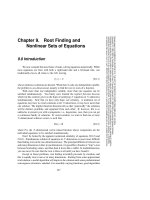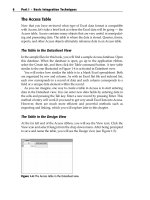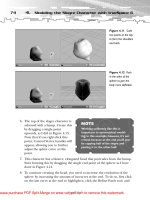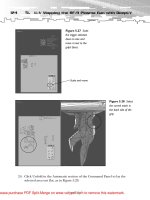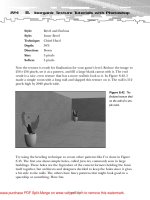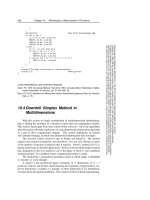Tài liệu Root Finding and Nonlinear Sets of Equations part 5 doc
Bạn đang xem bản rút gọn của tài liệu. Xem và tải ngay bản đầy đủ của tài liệu tại đây (139.05 KB, 8 trang )
362
Chapter 9. Root Finding and Nonlinear Sets of Equations
Sample page from NUMERICAL RECIPES IN C: THE ART OF SCIENTIFIC COMPUTING (ISBN 0-521-43108-5)
Copyright (C) 1988-1992 by Cambridge University Press.Programs Copyright (C) 1988-1992 by Numerical Recipes Software.
Permission is granted for internet users to make one paper copy for their own personal use. Further reproduction, or any copying of machine-
readable files (including this one) to any servercomputer, is strictly prohibited. To order Numerical Recipes books,diskettes, or CDROMs
visit website or call 1-800-872-7423 (North America only),or send email to (outside North America).
}
a=b; Move last best guess to a.
fa=fb;
if (fabs(d) > tol1) Evaluate new trial root.
b+=d;
else
b += SIGN(tol1,xm);
fb=(*func)(b);
}
nrerror("Maximum number of iterations exceeded in zbrent");
return 0.0; Never get here.
}
CITED REFERENCES AND FURTHER READING:
Brent, R.P. 1973,
Algorithms for Minimization without Derivatives
(Englewood Cliffs, NJ: Prentice-
Hall), Chapters 3, 4. [1]
Forsythe, G.E., Malcolm, M.A., and Moler, C.B. 1977,
Computer Methods for Mathematical
Computations
(Englewood Cliffs, NJ: Prentice-Hall),
§
7.2.
9.4 Newton-Raphson Method Using Derivative
Perhaps the mostcelebrated of allone-dimensionalroot-findingroutinesisNew-
ton’s method, also called the Newton-Raphson method. This method is distinguished
from the methods of previous sections by the fact that it requires the evaluation
of both the function f(x), and the derivative f
(x), at arbitrary points x.The
Newton-Raphson formula consists geometrically of extending the tangent line at a
current point x
i
until it crosses zero, then setting the next guess x
i+1
to the abscissa
of that zero-crossing (see Figure 9.4.1). Algebraically, the method derives from the
familiar Taylor series expansion of a function in the neighborhood of a point,
f(x + δ) ≈ f(x)+f
(x)δ+
f
(x)
2
δ
2
+ .... (9.4.1)
For small enough values of δ, and for well-behaved functions, the terms beyond
linear are unimportant, hence f(x + δ)=0implies
δ = −
f(x)
f
(x)
. (9.4.2)
Newton-Raphson is not restricted to one dimension. The method readily
generalizes to multiple dimensions, as we shall see in §9.6 and §9.7, below.
Far from a root, where the higher-order terms in the series are important, the
Newton-Raphson formula can give grossly inaccurate, meaningless corrections. For
instance, the initial guess for the root might be so far from the true root as to let
the search interval include a local maximum or minimum of the function. This can
be death to the method (see Figure 9.4.2). If an iteration places a trial guess near
such a local extremum, so that the first derivative nearly vanishes, then Newton-
Raphson sends its solution off to limbo, with vanishingly small hope of recovery.
9.4 Newton-Raphson Method Using Derivative
363
Sample page from NUMERICAL RECIPES IN C: THE ART OF SCIENTIFIC COMPUTING (ISBN 0-521-43108-5)
Copyright (C) 1988-1992 by Cambridge University Press.Programs Copyright (C) 1988-1992 by Numerical Recipes Software.
Permission is granted for internet users to make one paper copy for their own personal use. Further reproduction, or any copying of machine-
readable files (including this one) to any servercomputer, is strictly prohibited. To order Numerical Recipes books,diskettes, or CDROMs
visit website or call 1-800-872-7423 (North America only),or send email to (outside North America).
1
2
3
x
f(x)
Figure 9.4.1. Newton’s method extrapolates the local derivative to find the next estimate of the root. In
this example it works well and converges quadratically.
f(x)
x
1
2
3
Figure 9.4.2. Unfortunate case where Newton’s method encounters a local extremum and shoots off to
outer space. Here bracketing bounds, as in rtsafe, would save the day.
364
Chapter 9. Root Finding and Nonlinear Sets of Equations
Sample page from NUMERICAL RECIPES IN C: THE ART OF SCIENTIFIC COMPUTING (ISBN 0-521-43108-5)
Copyright (C) 1988-1992 by Cambridge University Press.Programs Copyright (C) 1988-1992 by Numerical Recipes Software.
Permission is granted for internet users to make one paper copy for their own personal use. Further reproduction, or any copying of machine-
readable files (including this one) to any servercomputer, is strictly prohibited. To order Numerical Recipes books,diskettes, or CDROMs
visit website or call 1-800-872-7423 (North America only),or send email to (outside North America).
x
f(x)
2
1
Figure 9.4.3. Unfortunate case where Newton’s method enters a nonconvergent cycle. This behavior
is often encountered when the function f is obtained, in whole or in part, by table interpolation. With
a better initial guess, the method would have succeeded.
Like most powerful tools, Newton-Raphson can be destructive used in inappropriate
circumstances. Figure 9.4.3 demonstrates another possible pathology.
Why do we call Newton-Raphson powerful? The answer lies in its rate of
convergence: Within a small distance of x the function and its derivative are
approximately:
f(x + )=f(x)+f
(x)+
2
f
(x)
2
+ ···,
f
(x+)=f
(x)+f
(x)+···
(9.4.3)
By the Newton-Raphson formula,
x
i+1
= x
i
−
f(x
i
)
f
(x
i
)
, (9.4.4)
so that
i+1
=
i
−
f(x
i
)
f
(x
i
)
. (9.4.5)
When a trial solution x
i
differs from the true root by
i
, we can use (9.4.3) to express
f(x
i
),f
(x
i
)in (9.4.4) in terms of
i
and derivatives at the root itself. The result is
a recurrence relation for the deviations of the trial solutions
i+1
= −
2
i
f
(x)
2f
(x)
. (9.4.6)
9.4 Newton-Raphson Method Using Derivative
365
Sample page from NUMERICAL RECIPES IN C: THE ART OF SCIENTIFIC COMPUTING (ISBN 0-521-43108-5)
Copyright (C) 1988-1992 by Cambridge University Press.Programs Copyright (C) 1988-1992 by Numerical Recipes Software.
Permission is granted for internet users to make one paper copy for their own personal use. Further reproduction, or any copying of machine-
readable files (including this one) to any servercomputer, is strictly prohibited. To order Numerical Recipes books,diskettes, or CDROMs
visit website or call 1-800-872-7423 (North America only),or send email to (outside North America).
Equation (9.4.6) says that Newton-Raphson converges quadratically (cf. equa-
tion 9.2.3). Near a root, the number of significant digits approximately doubles
with each step. This very strong convergence property makes Newton-Raphson the
method of choice for any function whose derivative can be evaluated efficiently, and
whose derivative is continuous and nonzero in the neighborhood of a root.
Even where Newton-Raphson is rejected for the early stages of convergence
(because of its poor global convergence properties), it is very common to “polish
up” a root with one or two steps of Newton-Raphson, which can multiply by two
or four its number of significant figures!
For an efficient realization of Newton-Raphson the user provides a routine that
evaluates both f(x) anditsfirst derivativef
(x) at thepoint x. The Newton-Raphson
formula can also be applied using a numerical difference to approximate the true
local derivative,
f
(x) ≈
f(x + dx)− f(x)
dx
. (9.4.7)
This is not, however, a recommended procedure for the following reasons: (i) You
are doing two function evaluations per step, so at best the superlinear order of
convergence will be only
√
2. (ii) If you take dx too small you will be wiped
out by roundoff, while if you take it too large your order of convergence will be
only linear, no better than using the initial evaluation f
(x
0
) for all subsequent
steps. Therefore, Newton-Raphson with numerical derivatives is (in one dimension)
always dominated by the secant method of §9.2. (In multidimensions, where there
is a paucity of available methods, Newton-Raphson with numerical derivatives must
be taken more seriously. See §§9.6–9.7.)
The following function calls a user supplied function funcd(x,fn,df) which
supplies the function value as fn and the derivative as df. We have included
input bounds on the root simply to be consistent with previous root-findingroutines:
Newton does not adjust bounds, and works only on local information at the point
x. The bounds are used only to pick the midpoint as the first guess, and to reject
the solution if it wanders outside of the bounds.
#include <math.h>
#define JMAX 20 Set to maximum number of iterations.
float rtnewt(void (*funcd)(float, float *, float *), float x1, float x2,
float xacc)
Using the Newton-Raphson method, find the root of a function known to lie in the interval
[
x1
,
x2
].Theroot
rtnewt
will be refined until its accuracy is known within ±
xacc
.
funcd
is a user-supplied routine that returns both the function value and the first derivative of the
function at the point
x
.
{
void nrerror(char error_text[]);
int j;
float df,dx,f,rtn;
rtn=0.5*(x1+x2); Initial guess.
for (j=1;j<=JMAX;j++) {
(*funcd)(rtn,&f,&df);
dx=f/df;
rtn -= dx;
if ((x1-rtn)*(rtn-x2) < 0.0)
nrerror("Jumped out of brackets in rtnewt");
366
Chapter 9. Root Finding and Nonlinear Sets of Equations
Sample page from NUMERICAL RECIPES IN C: THE ART OF SCIENTIFIC COMPUTING (ISBN 0-521-43108-5)
Copyright (C) 1988-1992 by Cambridge University Press.Programs Copyright (C) 1988-1992 by Numerical Recipes Software.
Permission is granted for internet users to make one paper copy for their own personal use. Further reproduction, or any copying of machine-
readable files (including this one) to any servercomputer, is strictly prohibited. To order Numerical Recipes books,diskettes, or CDROMs
visit website or call 1-800-872-7423 (North America only),or send email to (outside North America).
if (fabs(dx) < xacc) return rtn; Convergence.
}
nrerror("Maximum number of iterations exceeded in rtnewt");
return 0.0; Never get here.
}
While Newton-Raphson’s global convergence properties are poor, it is fairly
easy to design a fail-saferoutinethat utilizes a combinationof bisection and Newton-
Raphson. The hybrid algorithm takes a bisection step whenever Newton-Raphson
would take the solutionout of bounds, or whenever Newton-Raphsonis not reducing
the size of the brackets rapidly enough.
#include <math.h>
#define MAXIT 100 Maximum allowed number of iterations.
float rtsafe(void (*funcd)(float, float *, float *), float x1, float x2,
float xacc)
Using a combination of Newton-Raphson and bisection, find the root of a function bracketed
between
x1
and
x2
. The root, returned as the function value
rtsafe
, will be refined until
its accuracy is known within ±
xacc
.
funcd
is a user-supplied routine that returns both the
function value and the first derivative of the function.
{
void nrerror(char error_text[]);
int j;
float df,dx,dxold,f,fh,fl;
float temp,xh,xl,rts;
(*funcd)(x1,&fl,&df);
(*funcd)(x2,&fh,&df);
if ((fl > 0.0 && fh > 0.0) || (fl < 0.0 && fh < 0.0))
nrerror("Root must be bracketed in rtsafe");
if (fl == 0.0) return x1;
if (fh == 0.0) return x2;
if (fl < 0.0) { Orient the search so that f (xl) < 0.
xl=x1;
xh=x2;
} else {
xh=x1;
xl=x2;
}
rts=0.5*(x1+x2); Initialize the guess for root,
dxold=fabs(x2-x1); the “stepsize before last,”
dx=dxold; and the last step.
(*funcd)(rts,&f,&df);
for (j=1;j<=MAXIT;j++) { Loop over allowed iterations.
if ((((rts-xh)*df-f)*((rts-xl)*df-f) > 0.0) Bisect if Newton out of range,
|| (fabs(2.0*f) > fabs(dxold*df))) { or not decreasing fast enough.
dxold=dx;
dx=0.5*(xh-xl);
rts=xl+dx;
if (xl == rts) return rts; Change in root is negligible.
} else { Newton step acceptable. Take it.
dxold=dx;
dx=f/df;
temp=rts;
rts -= dx;
if (temp == rts) return rts;
}
if (fabs(dx) < xacc) return rts; Convergence criterion.
(*funcd)(rts,&f,&df);
The one new function evaluation per iteration.
